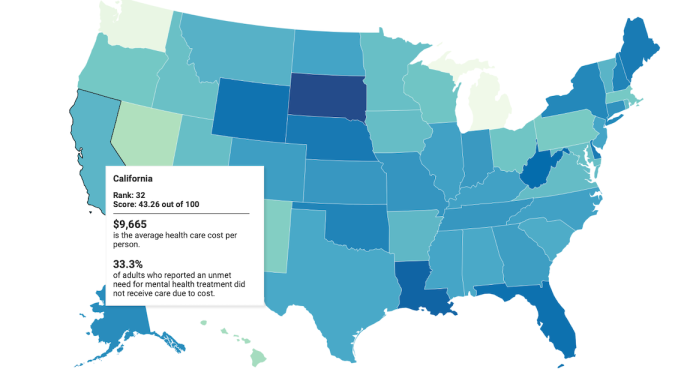Surprisingly, California ranks 20th on list of most affordable states for healthcare
By Les Masterson
Healthcare costs are forcing millions of Americans into medical debt, but it’s especially problematic in states like South Dakota, Louisiana and West Virginia, a new Forbes Advisor study found. Despite having a high cost of living, California actually ranked 20th in the list of least expensive states for healthcare.
Forbes Advisor used 11 metrics from Kaiser Family Foundation to find the most expensive and least expensive states for healthcare. Rather than solely focus on per capita healthcare costs, the study used additional information to better understand the situation in each state.
Those metrics include
- average healthcare cost increase over five years
- percent of residents who delayed care for themselves or a child over the past year because of costs
- the average health insurance premiums for employer-provided health plans and Silver tier health plans on the Affordable Care Act marketplace.
As part of the project, Forbes Advisor also conducted a survey of 2,000 Americans to ask about how medical debt is affecting them. The survey found that 44% believe a medical bill less than $1,000 is unaffordable, including 26% who said a medical bill of $500 or less is unaffordable.
That means pretty much any unexpected healthcare bill can put many Americans into a medical debt spiral. Even with the best health insurance, a consumer’s share of costs can quickly become unaffordable.

California Ranks No. 20 Among the States With the Lowest Healthcare Costs
California has one of the highest costs of living in the U.S. but things aren’t quite as bad when it comes to healthcare costs.
Forbes Advisor’s research found that California ranks 20th for the least expensive states for healthcare. Those results are largely driven by the fact that
- California employees pay the eighth-lowest average annual premiums for single coverage ($1,394.67 a year) at work and
- have the seventh-lowest average annual deductible for single coverage ($1,697 a year)
- Employees in California with family coverage also pay a lower-than-average annual deductible ($3,464).
Californians are not having as much trouble paying for healthcare than other states. Only 6% of California parents said they struggled to pay for their child’s medical bills, which tied for fourth-lowest percentage.
But things aren’t all rosy. Slightly more than 2 million California adults reported an unmet need for mental health treatment because of cost. That’s one-third of respondents, which puts the state at No. 14 for the lowest percentage, but still shows that millions are delaying needed care.
Most Expensive States for Healthcare
South Dakotans have the highest overall healthcare costs when considering 11 cost-related metrics. The state ranked ninth highest for healthcare costs per person and had the third highest increase in overall healthcare spending per person over a five-year period. The state was the fourth worst for families struggling to pay their child’s medical bills. Forbes Advisor found that 12% of families struggle to pay their children’s medical bills in the state.
Louisiana finished in second for worst state for healthcare costs. The state saw the fifth highest healthcare cost spike per person and residents with employer-sponsored health insurance pay some of the highest average costs in the nation.
West Virginia rounds out the list for the third worst states for healthcare costs. West Virginians pay the fourth highest health insurance premiums in the ACA marketplace, seventh-highest overall healthcare spending per person and eighth-highest per capita increase in health spending over a five-year period.
Least Expensive States for Healthcare
Healthcare can be expensive regardless of where you live, but residents in some states are faring better than others.
Michigan is the least expensive state for healthcare costs. The Great Lake State had the sixth lowest healthcare spending per person increase over a five-year period and Michiganders pay some of the lowest average health insurance costs for employer-provided plans and ACA marketplace plans.
Next up is Washington, which finished with the second lowest healthcare costs. Washington had the fourth-best ranking for the percentage of children whose families had trouble paying medical bills over the past 12 months. The state additionally had the 10th lowest increase in healthcare spending per person over a five-year period.
Nevada is third best when it comes to affordable healthcare costs. The state had the third lowest healthcare spending increase over a five-year period and ranked fourth for lowest healthcare expenditures per capita. But it wasn’t all great news for Nevada. Forbes Advisor found that Nevada has the 11th highest percentage of adults who delayed care over the past year because of costs.
Medical Debt Results in Delayed Care
Healthcare costs force Americans to delay necessary care, including medical procedures and prescription drugs.
A Forbes Advisor survey of 2,000 adults found that 27% of Americans put off doctor visits over the past year because of costs. Nearly 20% delayed a medical procedure, 19% didn’t fill a needed prescription, 18% pushed back a physical exam and 15% put off mental health treatment.
Nearly one-in-four (23%) said they are paying off medical debt. The debt forced many respondents to live on a tighter budget, postpone travel plans, delay home improvement projects and delay saving for retirement.
Most respondents facing a medical bill of at least $500 put that debt on a credit card or debit card. We found that 40% used a credit card, 30% put it on a debit card, 26% signed up for an installment plan with a hospital or other provider, 16% tapped into emergency savings and 12% borrowed money from a friend or family member.
Many respondents said they expect the medical debt will be with them for a while. Nearly 40% believe they will continue to pay off debt for at least three years.
Health insurance, inflation affect job choices
An employer’s health insurance is a deciding factor for Americans and can be a retention and recruitment tool for employers.
Nearly one-third (31%) of Americans with employer-sponsored health insurance said they stayed at a job they disliked because of the company’s health coverage. Another 8% said they left their job because they wanted better health insurance coverage.
Open enrollment is the time to sign up for or make changes to health insurance. Inflation is affecting health insurance decisions this year. Forbes Advisor found that 23% expect to select a plan with a lower premium because of inflation and 11% plan to choose a health plan with a lower deductible because of inflation.
Healthcare Costs Study Methodology
To measure the most and least expensive states for healthcare, Forbes Advisor examined data from the Kaiser Family Foundation for all 50 states and the District of Columbia and compared it across 11 metrics:
- Healthcare expenditures per capita:
20% of score. This metric includes out-of-pocket spending on all privately and publicly funded personal healthcare services and products such as hospital care, physician services, nursing home care and prescription drugs. We took a three-year average using data from 2018 to 2020.
- Percent of state residents who did not see a doctor in the past 12 months due to cost:
15% of score. For this metric, we took a three-year average using data from 2018 to 2020.
- Average individual health insurance premium for a Silver tier health plan:
10% of score. For this metric, we took a three-year average using data from 2020 to 2022.
- Average annual single premium per enrolled employee for employer-provided health insurance:
5% of score. For this metric, we took a three-year average using data from 2019 to 2021.
- Average annual plus one premium per enrolled employee for employer-sponsored health insurance:
5% of score. For this metric, we took a three-year average using data from 2019 to 2021.
- Average annual family premium per enrolled employee for employer-provided health insurance:
10% of score. For this metric, we took a three-year average using data from 2019 to 2021.
- Average annual deductible per enrolled employee for family coverage:
5% of score. For this metric, we took a three-year average, using data from 2019 to 2021.
- Average annual deductible per enrolled employee for single coverage:
5% of score. For this metric, we took a three-year average, using data from 2019 to 2021.
- Percent increase in out-of-pocket healthcare expenditure by state over a five year period:
15% of score. For this metric we calculated the five-year percent increase in healthcare spending from 2016 to 2020.
- Percent of adults reporting unmet need for mental health treatment in the past year who did not receive care because of cost:
5% of score. Data for this metric is from 2019 to 2020.
- Percent of children whose families struggled to pay for their child’s medical bills in the past 12 months:
5% of score. Data for this metric is from 2020.
Survey methodology
To see how Americans are being impacted by the high cost of healthcare, the Forbes Advisor team commissioned an online survey of 2,000 American adults, which was conducted by market research company OnePoll, in accordance with the Market Research Society’s code of conduct. Surveys were conducted from Oct. 28 to Nov. 1, 2022. The margin of error is +/- 2.2 points with 95% confidence. The OnePoll research team, a member of the MRS and has a corporate membership with the American Association for Public Opinion Research (AAPOR), oversaw the survey.

Les Masterson is a deputy editor and insurance analyst at Forbes Advisor. He has been a journalist, reporter, editor and content creator for more than 25 years. He has covered insurance for a decade, including auto, home, life and health insurance.
Contact: www.forbes.com/advisor/
